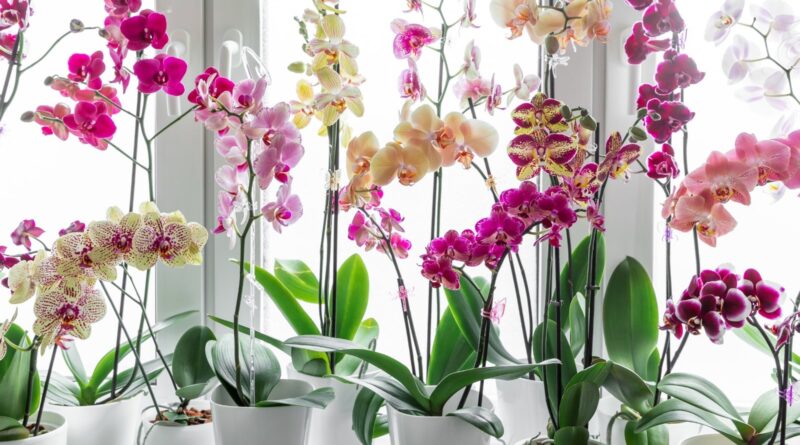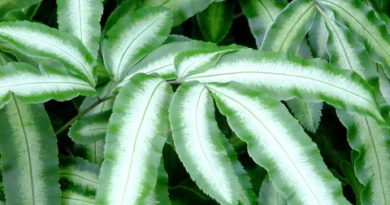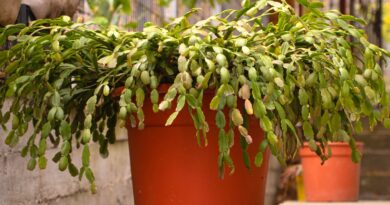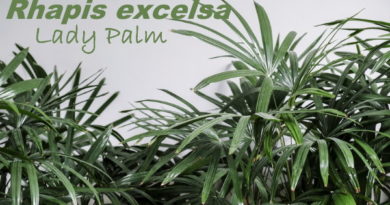27 Tropical Houseplants for a Lush Indoor Garden
You don’t have to live in the balmy, hot tropics to enjoy a jungle of exotic plants. Turn your home into a colorful tropical oasis with these unique and rare indoor houseplants!
Alocasia


The fantastic selections of the elephant ear plant group deserve a place in any houseplant collection. Modern varieties of alocasia beckon gardeners with their startling leaf forms and colors. There are a lot of dark brooding black and dark forest greens in the coloring of the new hybrids that are magnets for plant buyers. Who can resist a plant that has it all and black stems or black leaves with silver veins that contrast so well with other houseplants?
Their ancestors come from the tropical Amazon, where temperatures are high and humidity even higher, so they love moisture and need evenly moist soil and filtered bright light to thrive. If you can make a corner of your home into a mini rainforest, then these tropical beauties will be very happy.
Philodendron


From small to big leaves, there is a philodendron for every room in the home. These tough houseplants are super easy to grow and can either fill a space or cascade down a shelf with various leaf colors, shapes, and forms, including the ever-popular heart-shaped varieties.
There are nearly 500 varieties of this species, with more coming onto the market daily. The Princes and Princesses of the plant world, look out for ‘Prince of Orange’ and ‘Pink Princess’ to really add a splash of color to your surroundings. Each leaf that pokes out from the central stem is a new experience in coloring.
Philodendrons are tropical plants, so they will love moisture and a higher temperature, but research each plant for specific requirements as they are all a bit different.
Anthurium


The beautiful anthurium, also known as laceleaf or flamingo flower, is a member of the Araceae (arum) family native to tropical environments. The waxy spathes last a long time on the plants, making them one of the best flowering indoor plants you can find.
Red is the preferred color you will find commonly, but look out for new vibrant colors coming onto the market in variations that are attractive and easy to add to a shopping trolley.
These South American tropical plants need light to thrive but not so much that the leaves become scorched. Regular water and a balanced fertilizer will keep them looking their best. When they look a bit scrappy in a couple of years, they will be easy enough to propagate to get more plants.
Adiantum Ferns


Commonly called maidenhair ferns, these pretty lacy-leaved ferns are soft-looking yet tough and durable as houseplants as long as they get what they need. As with other tropical plants, they are happy in highly humid and moist environments, and most growers will agree that once a maidenhair fern has dried out, it’s almost impossible to revive it.
Avoid letting the plant dry out, but don’t let it become waterlogged, either. Moisture balance is the key to long-lasting maidenhair ferns. Add a good dose of filtered light and feed once a month in the growing season. They are so pretty that keeping them alive is worth a little effort.
Bromeliads


In the Bromeliad family, many different types of colorful plants can be grown indoors with some success. Watch out for the spikey-leaved ones and instead go for the Guzmania or Vriesea species as houseplants because they are thornless yet lovely and colorful.
Guzmanias, in particular, have little tufts of leaves poking out from the center of the leaves in vibrant yellow, orange, pink, and red – a colorful celebration of their Caribbean origin.
The epiphytes are grown in containers indoors and planted in the same mixture as you would for orchids. They like lots of moisture and daily spritzing in the spring and summer months. Feed at this time every two weeks with a liquid fertilizer.
Schefflera


Although a bit old-fashioned now with all the new varieties on the market, the umbrella tree is still an excellent tropical houseplant with its pretty fireworks-shaped glossy leaves.
There are some dwarf varieties and variegated ones that make for attractive alternatives. Like the other tropical plants on the list, this one doesn’t need as much water, but it’s best to leave it to dry out before watering again to prevent overwatering. They like feeding twice a month during the summer growing season and bright indirect light.
Strelitzia


The iconic South African Strelitzia reginae has become one of the most sought-after plants to have indoors, although, in their natural environment, they are outdoor plants. The large, glossy sword-shaped leaves accompanied by the bird of paradise flowers in orange and blue are what we look for in a houseplant.
They are large plants, requiring lots of light and average water. Plant it in a big enough container to be left for at least a few years; it does not like its roots disturbed and will sulk for years.
Strelitzia nicolai is a beautiful, lush tropical plant with white bird of paradise flowers for an even bigger indoor plant. In the wild, they can grow up to 30 feet tall, but confined to a container will be as big as the size of the container allows.
Monstera


A tropical list would not be complete without the iconic monstera in all its forms. The giant leaves make it. I have yet to find a plant lover who could resist the variegated monstera. Its white and green markings are captivating, although their price is ludicrous.
This giant vine originates in Central America and likes dappled shade, a large container, and plenty of water and humidity. Ensure this fast-growing plant has enough space to spread out those luscious Swiss cheese leaves.
Calathea


Calatheas are known for their exceptional leaf forms with patterns that will astound you. They like light but nowhere near direct sunlight, which will scorch the delicate leaves. If your plant packs its leaves up at night, then it is growing well and happy in its spot. They are similar to prayer-plants in this regard.
I tend to overwater mine, which they don’t like, but they also need a good dose of water. Most plants will be fine on a watering schedule altogether, not calatheas. They need checking often to ensure they have enough and have drained well before placing them back into pot covers or on trays. If you can get that right, then they are very rewarding houseplants. They have what I would call a personality when they fold up their leaves at night.
Crotons


Colorful waxy leaves are what crotons (Codiaeum variegatum) are all about. The colors are tropical, and the growing conditions must also mimic that. But the more sun they get, the more colorful the leaves, so a sunny window is best. Once they are in position and happy, try not to move them, as they can sulk and drop leaves.
Crotons like plenty of moisture, including humidity, so daily spritzing is good for them, and they can be fed twice in the growing season in spring and summer. Crotons tend to be large shrubs up to 8 feet tall in their natural environment, but indoors and in containers, they are significantly smaller.
African Violet


As their name suggests, African violets are native to Africa, specifically from the tropical rainforests on the border between Tanzania and Kenya. They have been around for ages as houseplants. They are known for longevity and their pretty flowers in shades of pink, purple, and white nestled amongst a bed of furry leaves.
It was always on my list of things to do not to water the leaves of an African violet as it may cause them to rot. However, I was recently reprimanded by a person at an African violet society who said that was nonsense. I still treat my violets the same way and water them under the leaves, unwilling to take the chance of losing them, and make sure they drain well.
They like a filtered sunny position and make good windowsill plants because of their small size. So many new colors have been added to the range of hybrids, some with unusual flowers, but all with a charming look.
Cordyline


Cordylines are strong, sculptural tropical plants that contrast well with lacy-leaved and softer plants. They have cane-like stems and leaves that fall like a fountain. The leaves range from thin to fat and have color variations, often tinged with red.
In this list of tropical plants, cordylines are perhaps one of the most tropical-looking and easy to grow. The only thing is that they don’t much like tap water and will occasionally have brown tips on their leaves due to the chemicals in tap water. Rainwater is ideal. Like all other tropical plants, they prefer high humidity, high temperatures, and plenty of moisture. Avoid sudden drafts or cold.
Dracaena


Various types of dracaenas make excellent houseplants. I am talking here specifically about the older varieties of dracaena, like Dracaena marginata (aka the dragon tree) with its thin starburst leaves and straight stems or Dracaena fragrans (corn plant) that have thicker leaves and thicker stems. These dracaenas are so easy to grow. Even a bit of stem in some water can result in more plants.
Like all tropical plants, they like water and humidity but are really so easy that you may have to have a schedule for dusting their leaves.
Other tropical indoor plants, like pleomele and sansevieria, have now been included in this group of plants.
Sansevieria


We still call these tough succulent types of plants sansevieria, although technically, they are now part of the Dracaena family. They may, on a molecular level, be part of a new family, but by look, they are very different.
The succulent leaves are upright, and some variegated with colored edges. One would expect they are more desert-type plants, but most come from Africa and Asia’s tropical and subtropical zones.
They perform well in just about any conditions you throw at them but will do best with bright indirect light, plenty of moisture, and high temperatures and humidity. If the leaves start to shrivel, I’d say it’s time to start taking care of it.
Yucca


Just the name suggests it should be part of your plant family. Yuccas are a plant from the agave family and come from various regions, some tropical and some hot and dry.
Their name is a mistake, but it has stuck. The plant was initially confused with the edible cassava or manioc plant that is cultivated extensively in the Americas. The cassava is also called yuca, which is the Spanish word for yucca.
The tall stems with spiky leaves make excellent houseplants as long as they have the correct light. Yuccas will grow as weaklings should they not be given lots of bright light. They are tough plants that require limited water – just once a week in spring and summer.
Spathiphyllum


Peace lilies are on my list of favorite houseplants because they almost talk to you. If they need water, their leaves droop and quickly perk up again once you give them a drink. If you provide them with a dose of liquid plant food every two weeks in spring and summer, they reward you with white sails that float about the dark green leaves.
The bigger-leaved varieties like ‘Sensation’ are magnificent for foliage alone. Look out for beautiful variegated versions. They are useful for lower-light areas but will do better with plenty of bright light, just not direct sunlight.
Orchids


For long-lasting flower power, you can’t go wrong with orchids. There are so many types of flower colors and shapes, but the stunning beauty of the tall or cascading stems makes them good houseplants.
They require very basic care, and after they have flowered, there are ways to make them bloom again, or you can do as I do and toss them outside on the patio to see what they will do with rainwater and neglect.
Begonias


Another of the flowering varieties of tropical indoor plants. Begonias, however, are often not bought for their flowering power but for their intricate, delicate, pretty leaves.
These are useful plants that can grow in a terrarium and in containers as long as they are not overwatered. They will decorate various zones of a home, but once settled and happy, don’t move them too quickly, or you may lose them just as quickly. They like regular feeding in the growing season. If they flower, deadhead them regularly to encourage more.
Pachira Aquatica


The money tree (Pachira Aquatica) is a favorite tropical houseplant for its leaves as much as its symbolism. The ‘aquatica’ species gives the game away; it’s a swamp plant used to being near water. This means that water is its primary focus; otherwise, it’s easy to grow and not too fussy. Give it plenty of bright light, and you are there. The size of the container you grow it in will determine the size so that you can have big or small plants.
The money tree symbolizes abundance, prosperity, and good luck, which is possibly why it’s such a popular plant all over the world.
Ficus


Rubber trees have long been popular houseplants due to their lovely, thick, rubbery leaves and adaptability in the home. Some varieties have gorgeous leaf coloring, making them even more popular in recent years. The iconic Ficus lyrata is a well-known houseplant with unforgettable massive leaves.
Some ficus plants are trees, which makes them useful for height-in-a-room design, but they need extra light to ensure all the leaves don’t drop. Most ficus varieties are as tough as nails, and it’s a well-known fact that they are so tough that they will grow in the smallest of cracks.
Kentia Palm


Tropical palm trees have to be part of a tropical houseplant list, and this one is one of my favorites. It gives the instant feeling of the tropics, and all that is needed is the beach sand and a cocktail with a paper umbrella in it.
This gorgeous specimen has lovely cascading palm leaves that fan out from the middle stem. They can do okay with less light than other plants but prefer bright light. They will do well with plenty of moisture and regular feeding, but other than that, they are effortless to care for.
Spider Plant


Chlorophytum comosum is an easy plant to grow, and it almost propagates itself by producing curved stems with baby spiders at the end of them that, when weighted down as they grow, touch the soil and begin a new plant. They are like creeping spiders, although not as creepy.
The variegated leaves in tufts make charming pot plants for coffee tables and desks. They are tolerant of a bit of neglect, needing average water, average temperature, and average humidity. A lot of average care, but in style, far from average.
ZZ Plant


Zamioculcas zamiifolia has a lot going for it, especially the dark green and black ones like ‘Raven’ that are just spectacular in a pot. You are desperate to look after this plant, but you are doing it a favor by neglecting it.
Overwatering can kill it quickly. If you think it needs water, leave it for a week. It can tolerate a range of light levels, including quite dark areas of the home, which makes it the perfect houseplant.
Out of the trending tropicals, the bloom-leaved varieties are hot right now but don’t forget the green ones. Also, a note of caution about the black leaves: they often revert back to their original green along the way, so don’t expect it to be perfect. I prefer that it has a kind of mind of its own.
Pothos


Pothos (Epipremnum aureum) has to be one of the easiest houseplants to own and are especially good for beginner gardeners. They are almost indestructible, relying on the occasional bit of water to survive.
The cascading nature of the plants allows them to be used on high shelves to trail down, create a fabulous display, and still not be too fussy about the light way up there on the shelf and the fact that watering may be occasional.
Give them bright light, water every couple of weeks, and a bit of fertilizer once a month in spring and summer, and you will be rewarded with lush foliage and a fast-growing houseplant that is super easy to propagate.
Hoyas


Called wax plants because of their waxy leaves, trailing hoyas are excellent houseplants and, with some time, produce the most stunning velvety clusters of flowers that are very special indeed. The leaves are also lush, and you can choose from varieties that have sharp or round leaves, all with a glossy shine and some with variegations.
They prefer medium-light, plenty of water in the summer with drier times during winter, medium to high humidity, and good feeding in summer.
Dieffenbachia


Dumb cane plants are known for their very appealing foliage and large leaves. The contrasting colors form a marbling effect on the surface of the leaves, making them irresistible.
Its rather bizarre common name is attributed to the sap it produces when cut, which can make a person speechless if it comes in contact with the throat. Why anyone would put their throat near the plants is a bit of a mystery, but clearly, it has been done in the past.
You can choose to use gloves when handling the plants. They prefer bright light and high humidity like other varieties hailing from the West Indies and the Caribbean.
Ponytail Palm Tree


A ponytail palm is not so much a palm as a yucca or an agave, but it does have the shape of a palm with a thick fleshy base and messy hairstyle of leaves on the top of the tall stem. In the wild, they can grow up to 30 feet tall, but confined to a pot, you can have them as desktop plants or 4-foot-long trees in large pots.
They like plenty of light, high temperatures, and relatively dry soils that are well-draining. Keep out of drafty areas and feed in spring and summer monthly.
Final Thoughts
There is so much richness in tropical plants, and each has its own uniqueness that is so rewarding in a houseplant. I would have them all if there were just a little more space in my house.




